|
|
Coins Around The World
|
A small percentage of early Lydian Greek coins have a legend.
A famous early electrum coin, the most ancient inscribed coin at present known, is from nearby Caria, Asia Minor. This coin has a Greek legend reading "Phaenos emi sema" which can be translated either as "I am the badge of Phanes" or as "I am the sign of light" or maybe "I am the tomb of light" or "I am the tomb of Phanes". The celebrated coins of Phanes are known to be amongst the earliest of Greek coins, a hemihekte of the issue was found in the famous foundation deposit of the temple of Artemis at Ephesos (this deposit is considered the oldest deposit of electrum coins discovered). One assumption is that Phanes was a wealthy merchant, another that this coin is associated with Apollo-Phanes and, due to the Deer, with Artemis (twin sister of the god of light Apollo-Phaneos). Although only seven Phanes type coins were discovered, it is also notable that 20% of all early electrum coins also have the Lion (symbol of Artemis-Potnia Theron) and the sun burst (symbol of Apollo-Phaneos). Alternatively it is stated that the inscribed Phanes maybe was the Halicarnassian mercenary of Amasis, mentioned by Herodotus, who escaped to the court of Cambyses, and became his guide in the invasion of Egypt in the year B.C. 527 or 525. According to Herodotus, this Phanes was buried alive by a sandstorm, together with 50000 Persian soldiers, while trying to conquer the temple of Amun–Zeus in Egypt. The fact that the Greek word "Phanes" also means light (or lamp), and the word "sema" also means tomb, makes this coin a famous and controversial one.
Another possible candidate for first metal coins come from China. The earliest known Chinese metal tokens were made ca. 900 BC, discovered in a tomb near Anyang. These were replicas in bronze of earlier Chinese money, cowry shells, so they were named Bronze Shell.
Most numismatists, however, regard these as well as later Chinese bronzes that were replicas of knives, spades, and hoes as money but not as coins because they did not at least initially carry a mark or marks certifying them to be of a definite exchange value.
|
|









